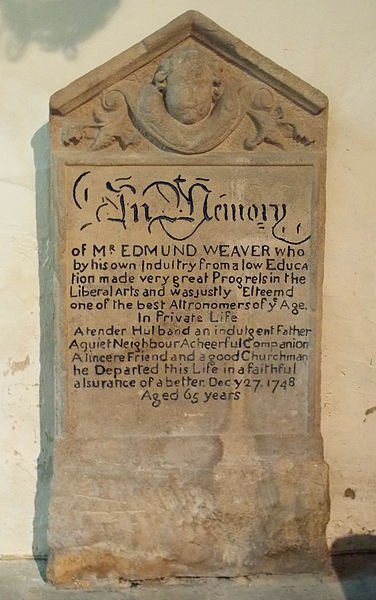A few years ago, when I was looking around the University of Lincoln for my MA course, the guide, a 2nd year undergraduate, said he hadn’t known Isaac Newton was from Lincolnshire until he’d come to the University. I think he was from Nottinghamshire. Sir Isaac isn’t our only famous scientist however.
A contemporary of the famous Newton, from a much less wealthy family, and now the namesake of an annual lecture held at the University of Lincoln School of Mathematics and Physics, Edmund Weaver, was born, lived and died in the county. He lived in Frieston and is buried in Caythorpe. Born sometime in 1683, he died in late December 1748. In his 65 years he produced some of the earliest land surveys of Lincolnshire and accurately predicted the 1769 Transit of Venus as curved.

In memory of Mr Edmund Weaver who by his own Industry from a low Education made very great Progress in the Liberal Arts and was justly Esteemd one of the best Astronomers of ye (the: y = th) age.
In Private Life A tender Husband, an indulgent Father, A quiet Neighbour, A cheerful Companion, A sincere Friend and a good Churchman he Departed this Life in a Faithful assurance of a better. Dec y 27 1748. Aged 65 years.
A self-educated man who made his living as a land surveyor, Weaver produced a magazine, The British Astronomer, in the years 1725, 1731 and 1741. It was in the 1741 issue that he predicted the path of Venus in 1769 and that the paths of planets are elliptical. His work got the attention of the contemporary journal Royal Astronomer.
His survey of Lincolnshire was less successful. At the end of his life the project had barely been started, with only a few roads mapped. It would be over a hundred years before a full survey of the shire was completed.
William Stukeley, a friend and antiquarian, described the otherwise obscure astronomer as “a very uncommon genius, who had made himself master in astronomy and was scarcely to be accounted the second in the kingdom” in the Philosophical Transactions of 1754, a quote that was later republished in The Observatory, Vol. 23, p. 318-319 (1900) as part of a letter from one W. T. Lynn, of Blackheath. It is from these tiny references that we know anything about Weaver at all.
The University of Lincoln School of Mathematics and Physics held its 2nd Annual Edmund Weaver Lecture earlier this month, titled ‘Fantastic worlds and where to find them’, presented by Dr Phil Sutton. I attended it because I’m interested in exoplanets and occasionally write science fiction, so I want to make my writing fairly accurate (it’s fiction, I’m allowed some playing room). I thought exomoons provided some interesting territory for exploration in fiction.
Nothing presented was new to me, although I enjoyed the images and the lecture clarified some of my confusion about how exoplanets are detected. Some of the written descriptions I’ve read didn’t make things clear, but the images of transit photometry graphs made sense of the descriptions. See The Planetary Society website for more on this subject and other means of detecting exoplanets.
The lecture was well attended and I was pleased to see young girls there and asking questions at the end. Outside the lecture theatre there are a selection boards with pictures and information about women scientists of the past. I hope it encourages girls to consider maths and physics as a future study path and career. I was apparently good at physics but chose chemistry and biology instead, because our physics teachers tended to the misogynistic, and I was already the only girl in A Level maths, I didn’t feel comfortable being the only girl in thd physics class too, especially as it would gave been with the same people I was in maths with, and some of them were utter twerps.
Right, it’s almost 1.30 am, I’m tired and full of cold, so I’m going to bed.

